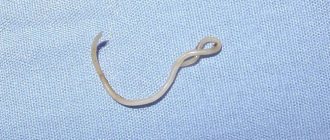Symptoms
- The dog develops a wobbling gait and coordination of movements is impaired.
- The dog begins to hunch over, spends a lot of time in one position and tries to shift the load to its front legs. This is especially noticeable when she is about to jump on the sofa or overcome some obstacle while walking.
- There is trembling of the limbs, shortness of breath, and inability to fully bend over to a bowl of food.
- There are difficulties when urinating and defecating.
In severe cases, a sharp development of paralysis and, as a consequence, complete immobility of the rear part of the body is possible. Since there is no universal explanation for severe neuralgia, all diagnoses can only be made by a specialized doctor.
Ataxia in dogs: symptoms
In Greek, the word ataxia means “without order.” This description speaks volumes about the symptoms of the disease. With progressive ataxia, the dog looks “drunk”: falls, stumbles, turns its head, crouches when turning. At the same time, moving in a straight line is quite easy for sick dogs, but the pet is not able to climb the stairs, walk along a winding corridor, or change the trajectory of movement.
Dogs with ataxia may even bump into large objects, are unable to jump, make a turn, are unable to chase a person or other animal, or play with their relatives. Animals with a damaged cerebellum move with small “goose steps”, and at the same time they can walk too wide, placing their paw much further than necessary.
Some owners confuse the manifestations of ataxia with epilepsy, as animals often shudder, suffer from dizziness, their head shakes, their eyelids and chin tremble. Convulsive jerks and movements usually occur in a situation where the animal is concentrated, for example, eating or trying to plot a route.
Video - Ataxia in dogs
Discopathy, disc herniation
It is typical for dogs of small breeds that have a genetic predisposition to instability of the intervertebral discs. As a rule, these are pugs, Pekingese, French bulldogs, and poodles. Disc displacement leads to compression of the spinal cord, which, in the worst case scenario, can lead not only to complete immobilization of the limbs, but also to death.
Due to the fact that the dog begins to experience acute pain, it tries to limit its movement as much as possible. Often freezes in a certain position, hunching the spine and retracting the neck, trembling and eventually simply falling to the floor. If the pain is not very critical, then external signs may be less pronounced. The pet will seem to drag its paws behind itself, evade jumps and sudden movements, and bend over with difficulty.
Injuries
This category includes all injuries and damage suffered by an animal, either accidentally or intentionally. For example, a dog may get hurt in a fight, get hit by a car, slip on ice, fall into a hole, or hit hard on some hard surface. If the spine is damaged as a result of injury, then the likelihood that the dog will have problems with coordination is very high.
Swelling appears at the site of the bruise/wound, which leads to compression of the spinal cord and adjacent nerves. Blood circulation in the damaged area is disrupted, therefore, nerve cells do not receive adequate nutrition and nerve impulses to the peripheral system are hampered, and tissue sensitivity is lost. The presence of a serious injury can lead to irreversible consequences - rupture of the spinal cord.
Dogs with a stretched “format” are the most vulnerable to spinal injuries—dachshunds and basset hounds. It is enough for them to stumble or turn sharply for the front and hind legs to move in different directions. Despite the elasticity of the intervertebral ligaments, which align the spine and fix it in the desired position, the spinal cord can be damaged in a matter of moments.
Treatment of impaired motor coordination in dogs.
If you are faced with a similar problem, but do not know why the dog is unsteady, you should immediately contact a veterinarian for a full examination. Identifying the cause is critical and may require a range of diagnostic procedures, ranging from ultrasound and x-rays to, in some cases, a CT scan of the brain.
Further treatment is based on the established diagnosis and involves drug elimination of the causes. Unfortunately, in some situations, surgery may be required to solve problems, so if you notice a lack of coordination in your dog, prompt action is very important and will help alleviate the animal’s suffering.
Has your dog started to lose balance when turning and falling? , but not at all from the cold? Such symptoms are characteristic of ataxia.
Ataxia refers to genetic diseases in animals. For the disease to appear in a puppy, the recessive gene must be present in both parents.
Modern research methods make it possible to identify a hereditary mutation, therefore such dogs are not allowed to breed. But ataxia can occur against the background of other pathologies in the body. Let's try to figure out what factors contribute to the development of the disease, how cerebellar ataxia manifests itself and how to treat it.
Currently, there are methods to detect ataxia in dogs.
Causes of the disease
An animal can get the disease from its parents, but more often the pathology is acquired in the process of life. The appearance of signs of cerebellar ataxia is influenced by the following factors:
- Previously suffered infectious diseases in which the cerebellum was damaged.
- Trauma to the skull with the formation of hematomas.
- Brain tumor.
- Damage to the cranial nerve.
Otitis media can cause the disease.
Symptoms of ataxia
Before making a turn, a dog with ataxia may crouch for balance.
Cerebellar ataxia is the most severe of other forms of the disease, and also difficult to cure. The cerebellum is the part of the brain that is responsible for the ability to move and coordinate in space.
- Damage to the cerebellum caused by injury or disease leads to problems with coordination and the ability to move and balance
. Sometimes the disease causes the dog to lose spatial orientation. She ceases to navigate the area and does not even recognize her native places. - With ataxia, changes in the dog's movement become immediately noticeable
. A “drunk” gait appears. The animal moves quite normally along a straight path, but when trying to turn, problems arise. When turning, the dog crouches, trying to maintain balance. If you turn quickly, you may not calculate the opportunity and fall. - The disease tends to progress
. Coordination problems get worse over time. A sick animal begins to bump into objects. The gait becomes like that of a goose. - With ataxia, the pet suffers from attacks of dizziness
. He may fall, and his eyelids will tremble. Many owners perceive the manifestation of nystagmus as. Even veterinarians sometimes misdiagnose the disease after seeing the animal's convulsive shudders. - The dog trembles when trying to turn sharply or keep attention on a certain object
. Very often this problem occurs during feeding. The pet cannot eat normally, as it begins to tremble and hit its face on the plate. - The animal may panic, try to hide in the far corner and not go anywhere
. Constant malnutrition, dizziness and panic attacks worsen the dog’s condition, and progressive weakness appears. The animal is fading away before our eyes.
What should a dog owner be wary of? All of the above symptoms are difficult to miss; in addition, the pet has a constant tilt of the head, hearing may deteriorate, behavior and gait change. Difficulties arise when climbing stairs.
The pet requires a thorough examination to exclude the presence of other diseases.
Hip diseases
Large breed dogs are usually at risk - Dobermans, Rottweilers, Great Danes, St. Bernards, etc. Often a similar diagnosis is made to shepherd dogs at the age of 6-12 months. Problems with the hip joints can be periodic, subsiding and worsening under the influence of various reasons. For example, from insufficient or excessive physical activity.
The dog may fall on its paws after waking up or after an active walk. It is not at all necessary that the disease will affect both limbs at once. There is a high probability that the dog will only pull one paw. Possible causes of dysplasia:
- Genetic predisposition;
- Poor nutrition;
- Obesity;
- Improper conditions of detention.
Important: despite the fact that dysplasia is classified as an incurable disease, modern medicine can provide animals with fairly comfortable living conditions.
Treatment of ataxia in dogs
The treatment regimen for ataxia in dogs depends on the cause that caused it. If the cause of ataxia is a tumor compressing the cerebellum or nerve canals, its surgical removal can result in significant improvement, up to complete recovery.
If ataxia is caused by genetics, then it is impossible to cure the brain damage. If the stage of damage is severe, veterinarians consider it humane to euthanize the dog so as not to condemn it to years of unpleasant and painful existence. In cases where ataxia is relatively mild, the animal's quality of life can be improved.
The therapeutic regimen for maintaining an animal with ataxia includes painkillers, medications that relieve nervous tension, antispasmodics, anti-inflammatory drugs, vitamin complexes (in particular, B-group vitamins).
The owner of a dog who has been diagnosed with ataxia must provide the pet with the most comfortable conditions possible: select equipment for walking in which the animal can be well controlled (for example, a harness), secure the room where the dog is. It will never be possible to cure genetic ataxia, and the owner must be prepared for the fact that his pet will be dependent on his attention and patience all his life.
Ataxia in dogs is not always automatically a death sentence. With superficial lesions, the animal only needs emergency measures, and thinking about euthanasia is too hasty. This is confirmed by the long-term life of a significant percentage of dogs surrounded by the necessary care.
Ataxia is a neurological disorder of a congenital or acquired nature, which is manifested by lack of coordination in the movements of an animal. At the same time, muscle strength is often preserved in the limbs, and any involuntary movements, paresis or excessive spasticity may be absent. The animal's consciousness often does not change.
Myositis
In simple terms, this is inflammation of the muscles. As a rule, this condition is typical after an unusual training session with an increased load for the dog or after being in a draft for a long time. With myositis, the animal may step heavily on its paws, as if overcoming itself, or if the inflammation is too extensive, involuntarily bend its limbs and fall to the ground. Symptoms usually go away on their own after a few days, and massages and rubbing of the muscles of the spine and back of the body can help improve well-being.
Causes of other types of ataxia
They may be different. As you remember, vestibular and sensory ataxia develop against the background of damage to the vestibular apparatus, or nerve cords. The first reason that comes to mind in these cases is oncology
. If the tumor damages these important organs, many unpleasant symptoms will develop, which we have already discussed above.
Loss of coordination in a dog, or peripheral vestibular syndrome, is a rather alarming problem that can frighten even an experienced breeder. Very often, for no apparent reason, the dog loses coordination, cannot hold its head straight and cannot even walk. All this is often accompanied by profuse salivation, vomiting, rapid breathing and heartbeat, and twitching of the limbs.
If a dog sways from side to side when walking, falls and does not control its movements, then this can be for several main reasons. Quite often the problem is inflammation of the inner and middle ear or a congenital abnormality of the hearing organs. In adult dogs, idiopathic vestibular syndrome is also common, which lasts about three days and goes away on its own. In addition, a sudden loss of coordination of movement in dogs can be a consequence of diseases such as:
- Tumor in the inner ear.
Stroke
Strokes in dogs are quite rare. The so-called vestibular syndrome is more common in veterinary practice. In both cases, the animal exhibits characteristic symptoms:
- The dog behaves restlessly, spins in place, and trembles.
- Refuses food.
- He begins to breathe hard and roll his eyes.
- Falls on its paws, rolls over onto its back or side.
The difficulty of treatment lies in the fact that clinical signs of vestibular syndrome can arise and disappear without any warning or explanation.
Information about the violation
In fact, there is no single correct answer to the question of what ataxia is. The fact is that this cannot be called a single disease, since ataxia simply indicates the appearance of some symptoms, here is a list of them:
- loss of coordination, which occurs suddenly in all situations;
- situations involving loss of balance;
- sudden shaking;
- There are even situations when an animal falls for no reason.
Let's also mention the classification of ataxia, here are the main types:
- vestibular;
- sensitive;
- cerebellar
It is worth noting that each type has its own characteristic features, as well as reasons for its appearance. The first type of ataxia indicates disturbances in the functioning of the vestibular apparatus, which is necessary for the animal to successfully maintain balance; without it, it will be difficult for the dog to be in space. This will be expressed by the fact that she will not even be able to hold her head normally in one position, there will also be a slight list when walking, and instability will end with the dog constantly falling or even spinning in place. Experts note another characteristic symptom - uncoordinated eye movements, as well as a constant feeling of drowsiness, less often - numbness.
Sensitive ataxia
As for sensitive ataxia, it develops in cases of damage to the Burdach or Gaulle bundles, and it can also appear due to disorders in the spinal cord. The main sign of this type of ataxia is considered to be various disturbances in the process of walking; in most situations, owners notice that the dog begins to look at its feet all the time while moving. It is worth mentioning that with serious lesions, the dog may even lose the ability to be in the “standing” and “sitting” positions. For this reason, at the first manifestations, you must consult a doctor, do not hesitate!
Note!
The previously discussed types of ataxia cannot affect various behavioral aspects of the pet. Thus, the dog’s behavior partially does not change; of course, the previously described disorders are observed, but this is not so serious (the problem can be solved by contacting a specialist, and mental abnormalities are not observed). For this reason, specialists can easily diagnose the disease, distinguishing it from various infections.
Since these pathologies are relatively minor, it is necessary to consider cerebellar ataxia, because it is the most difficult to treat, even with timely consultation with a specialist. If this area is damaged, the dog’s coordination of movements, as well as its balance, are significantly impaired. Even with a slight delay, loss of control over the pet’s motor function will follow. In more rare situations, more dangerous symptoms are observed, namely, a violation of the ability to spatial orientation; it is worth mentioning that sometimes dogs even cease to recognize their owners, as well as the place where they have always lived.
Such damage to the cerebellum, located in the brain, is often caused by a tumor, and occasionally an infection can be the cause. Despite this, in most situations such manifestations occur due to defects present from birth. The essence of the mentioned defects is that the death of normal neurons is caused. In such situations, the specialist makes a diagnosis called “hereditary cerebellar ataxia.”
Let us mention that such diseases are transmitted by a recessive gene, that is, such disorders must be present in both individuals participating in the birth of the animal. For this reason, cerebellar ataxia is considered a fairly rare disease, because conscientious breeders do everything possible to combat inherited diseases (dogs with such diseases are simply not allowed to breed).
Loss of coordination due to poisoning
Why dogs can still lose coordination - the reasons for the appearance of other types of illness The reasons for the development of loss of coordination can be different. As mentioned earlier, these types of disease develop against the background of damage to something. Most often, the main reason for their appearance is oncology; such a neoplasm can damage any important organs, which will be accompanied by a large number of unpleasant symptoms, the main ones of which have already been discussed in this material.
It is worth mentioning that the cause of poor coordination in dogs can also be the penetration of toxins into the body. It cannot be argued that this only means poison, since any substances that are released into the bloodstream by helminths (worms) can act as toxins. If a dog has large worms, the problem can be huge, because everything can turn into encephalopathy, so disorders associated with motor function are not the worst manifestation of helminths.
Despite this, the most common cause is poisoning. Almost all dogs pick up some things on the street, and in some situations you can come across poisoned bait, despite the fact that these days they are quite rare. In such situations, in the absence of medical assistance in the first few hours, everything will end up with much more serious manifestations, because, most likely, the pet will die.
The problem may also be due to autoimmune diseases; systemic lupus is most often to blame. Such an ailment has a characteristic feature because if it is present, the pet’s body will begin to destroy itself. Experts note that the nervous system may be the first system to be affected, which is why poor coordination of movements often develops.
Important!
Don’t forget about injuries, since a dog that gets hit by a car can have a lot of serious injuries that can be observed throughout the body. In this case, ataxia is not uncommon. As you might guess, in this case it is very important to get the dog to a medical facility as quickly as possible. If the veterinarian does not look at it, then any hematoma in the meninges can lead to death!
Spondylosis
The insidiousness of the disease is that it progresses very slowly and is not diagnosed in the initial stages. There is a gradual “aging” of local areas of the spine through the formation of special growths on the intervertebral discs - the so-called osteophytes. Spondylosis is more typical for older animals, although due to poor nutrition and living conditions, young dogs can also fall into the risk zone.
Important: dogs can also fall on their paws from exhaustion. This applies more to street animals than to domestic ones.
Treatment
None of the above diseases can be treated at home, but require careful diagnosis and treatment in a hospital setting. Unfortunately, primary clinical signs of pathology are often not noticed by animal owners, or they are not of particular importance.
The dog ends up in the hands of veterinarians when its limbs are clearly immobilized or there is severe pain. However, it is still possible to relieve pain and restore partial or complete motor functions.
To make a diagnosis, a visual examination of the pet is performed to determine the presence of sensitivity, as well as radiography and MRI. Additionally, blood, urine, puncture, etc. tests may be taken. Therapy may include taking anti-inflammatory drugs, painkillers, chondoprotectors and other medications, depending on the doctor’s opinion.
Diagnosis and treatment
It is worth mentioning the diagnostic process, but first you should understand that it is not possible to identify the problem yourself, and it is prohibited to do so, because the situation may worsen. If you suspect ataxia, you should contact your veterinarian immediately. An interesting fact is that no test or diagnostic method has yet been invented that would determine the presence of ataxia of any type.
The veterinarian makes a diagnosis after a full examination and questioning of the owners, and sometimes it is necessary to do a whole range of various tests, which includes such as a urine test and blood drawing. Sometimes it is useful to do an MRI, but not everywhere there is such an opportunity, and such a procedure will be very expensive. For this reason, specialists most often limit themselves to X-rays. Other tests are also prescribed, but they all depend on the results of the examination.
As you might guess, the treatment process will depend entirely on the cause of the disease. If a dangerous infectious disease is detected, the dog will be given strong antibiotics. If the problem is a tumor, then veterinarians will perform surgery.
As for more complex situations, for example, when ataxia is caused by a hereditary defect, it is not possible to cure it. For this reason, specialists can only prescribe supportive treatment to maintain a normal standard of living for the pet. Such therapy includes sedatives that can relieve panic.
As for the treatment of various movement disorders, only specific medications can be used for this purpose. It is strictly forbidden to self-medicate an animal, because serious drugs will only make it worse if given incorrectly.
Important!
If your animal's ataxia is of the cerebellar type, then you must adapt the apartment to his life. The dog should be given a room where there are no sharp corners or objects, because over time his condition will deteriorate greatly even if he takes the necessary medications prescribed by the veterinarian.
About the author: Anna Aleksandrovna Maksimenkova
Practicing veterinarian in a private clinic.
Directions: therapy, oncology, surgery. Read more about me in the “About Us” section. A sudden loss of coordination of movements is explained by a disease of the balance organs and is called “vestibular syndrome of dogs (or cats).” The symptoms can look frightening: an apparently healthy animal suddenly cannot rise to its feet, falls, flounders, and looks frightened. Salivation, vomiting, and rapid breathing may also be evident. The head is tilted to the side, the muzzle is asymmetrical. The first thing that comes to mind in such cases is in an animal. But stroke is perhaps the rarest cause of these symptoms. Most often, such manifestations are caused by disruption of the balance organs located outside the brain - the so-called peripheral vestibular syndrome
.
The causes of peripheral vestibular syndrome are as follows:
— Inflammation of the middle and inner ear (otitis media) is the most common cause of peripheral vestibular syndrome. The organ of balance - the labyrinth of the cochlea - is inextricably linked with the organ of hearing. Inflammation during otitis media can spread to the cochlear labyrinth and cause disruption of its functioning. In this case, treatment should include antibiotics and anti-inflammatory drugs. Dealing with this disease can take a lot of time and effort. Symptoms of vestibular disorder disappear in 10-14 days. When treating otitis media, the use of ototoxic drugs such as chlorhexidine and aminoglycoside antibiotics should be avoided.
Neoplasms (tumors, polyps, cysts) of the inner ear, eustachian tube, eardrum. To diagnose these formations, conventional examination and otoscopy are not enough, but additional visual diagnostic methods and cytological analysis are required. The most effective method of treating tumors is surgery.
Idiopathic vestibular syndrome is the second most common cause of balance problems. In cats, this disease occurs most often during the summer months. Cats of all ages are affected. Dogs get sick more often at older ages and regardless of the time of year. 72 hours after the onset of symptoms, a significant improvement occurs - nystagmus (rhythmic movements of the eyeballs) and nausea almost disappear, appetite and the ability to walk appear. After 7 days the animal can move normally. The head tilt can persist for a longer time - up to 2 months. No specific treatment has been developed. Recovery occurs without treatment, but recurrence of the disease is possible.
Use of ototoxic drugs (aminoglycoside antibiotics, chlorhexidine, metronidazole)
Congenital anomalies in the development of the organ of hearing and balance have been described in such breeds as: and in some others. Congenital disorders appear from birth or at 3-4 weeks of age. Some animals live with this disorder their entire lives. In some cases, spontaneous recovery occurs by 3-4 months of age. No treatment has been developed.
Temporal bone injury.
Let us remember that above we discussed diseases that do not affect the brain. This is the most common cause of sudden loss of coordination in pets. Less commonly, vestibular disorders are a consequence of diseases affecting the brain
.
Symptoms of imbalance that occur when these structures are affected are called central vestibular syndrome
.
The causes of central vestibular disorders are the following diseases:
Infectious diseases of the brain: canine distemper, toxoplasmosis, cryptococcosis.
Inflammatory diseases of the nervous system: granulomatous meningoencephalomyelitis, necrotizing meningoencephalomyelitis.
Brain tumors – meningiomas, lymphomas.
Vascular diseases of the brain: ischemic, hemorrhagic stroke as a result of hypertension, hormonal disorders, sepsis, bleeding disorders, thrombosis of cerebral vessels.
The prognosis for these diseases is more cautious than for peripheral disorders. As a rule, in addition to symptoms of imbalance, the animal also exhibits other neurological disorders, as well as symptoms of damage to other organs and systems.
Symptoms of peripheral and central vestibular syndrome are listed in the table:
In each case of impaired coordination of movements, doctors need the most complete information about the animal. Therefore, when faced with cases of imbalance in animals, specialists conduct a particularly thorough examination. Depending on what disease the symptoms and course of vestibular disorders indicate, a diagnostic and treatment plan is drawn up. In some cases, diagnosis may be limited to a routine examination of the animal, examination of the ears, general and clinical blood tests, and this will be sufficient to establish a diagnosis and prescribe treatment. In more complex cases, advanced diagnostics may be needed - tests for viral and bacterial infections, tests for thyroid and adrenal hormones, x-rays, ultrasound of internal organs, computed tomography of the brain, cerebrospinal fluid analysis.
Sudden loss of coordination in dogs is called peripheral vestibular syndrome. It looks scary. A seemingly healthy animal suddenly falls, cannot rise to its feet, and flounders.
Also, drooling, rapid breathing. The dog's head is tilted to the side. The cause of this disease is a disruption of the balance organs. First of all, otitis media can lead to this. Inflammation in the ear can spread to the organ of balance - the labyrinth of the cochlea, and cause a lack of coordination.
The second most common cause of balance disorders is idiopathic vestibular syndrome. More often it affects adult dogs. It goes away on its own after 72 hours - the animal regains the ability to walk, its nausea disappears. But the head tilt may persist for up to two months. There are also congenital hearing abnormalities.
Most often they are found in German shepherds, beagles, and English cocker spaniels. They appear already at 3-4 weeks of age. To a lack of coordination, a cyst or polyps that appear in the inner ear, on the eardrum or eustachian tube.
To diagnose them, you will need otoscopy and cytological analysis. Injury to the temporal bone is also possible. Less commonly, loss of coordination occurs as a result of diseases affecting the brain. This can be toxoplasmosis, canine distemper, cryptococcosis.










